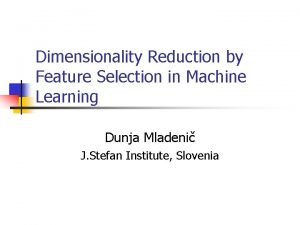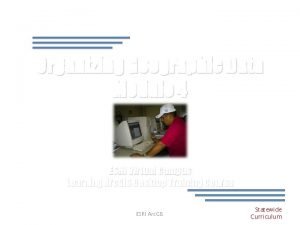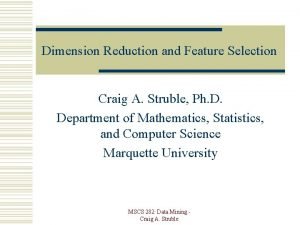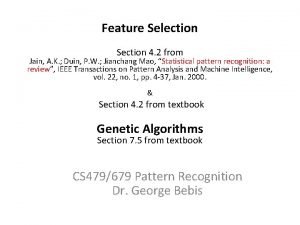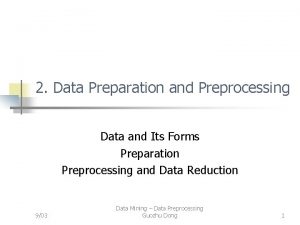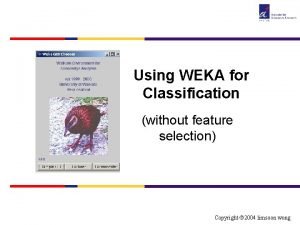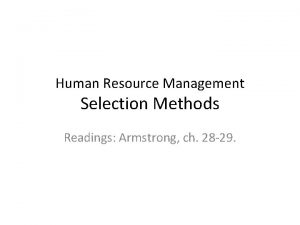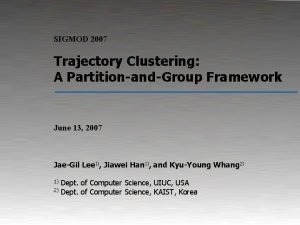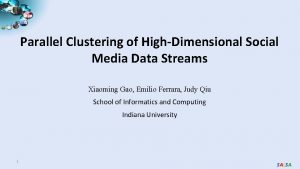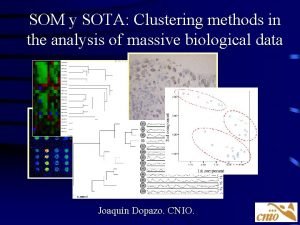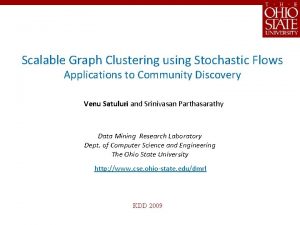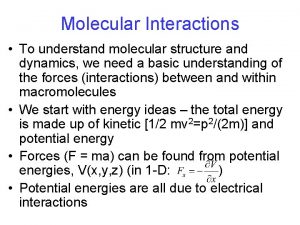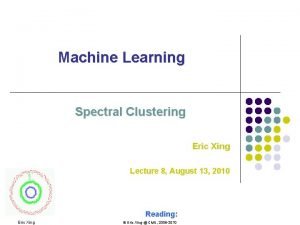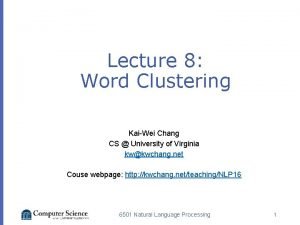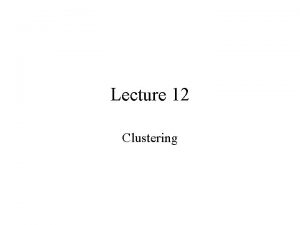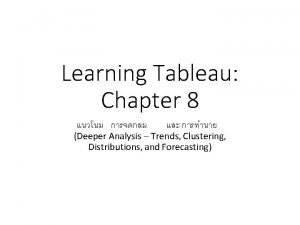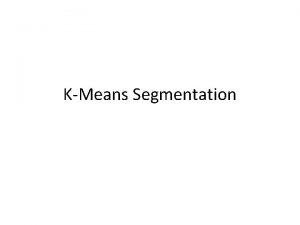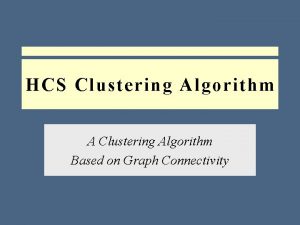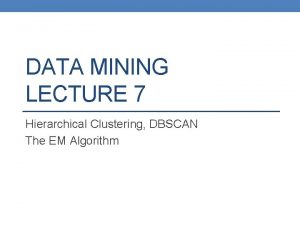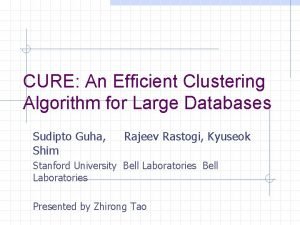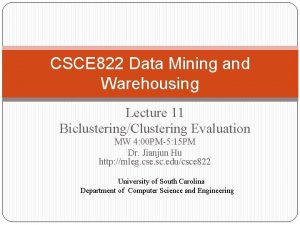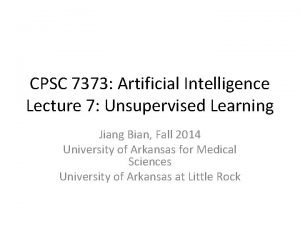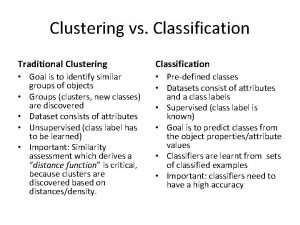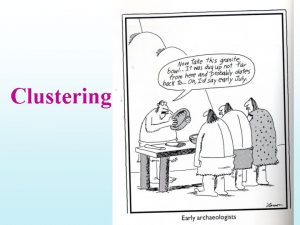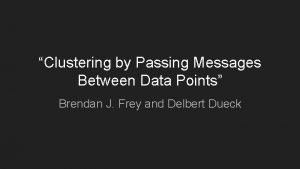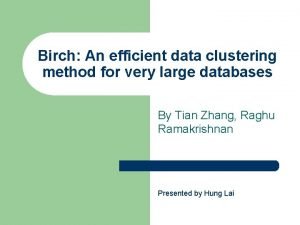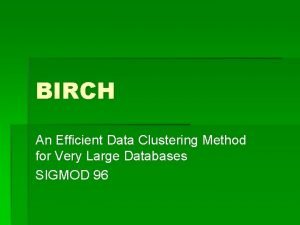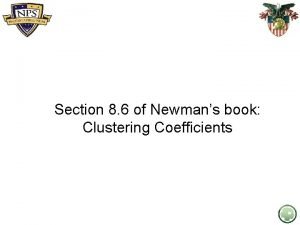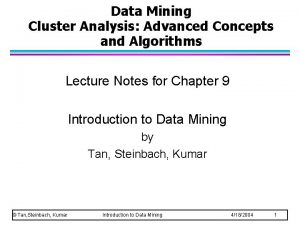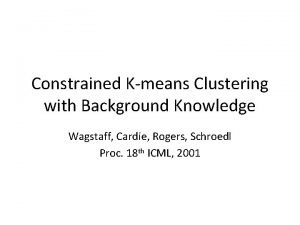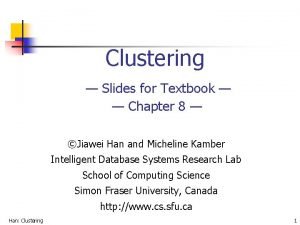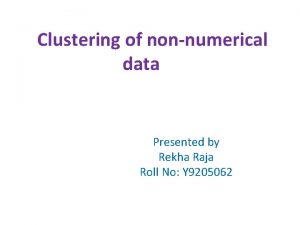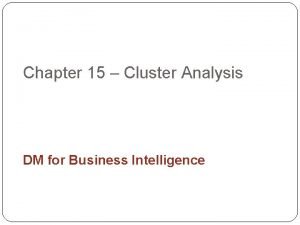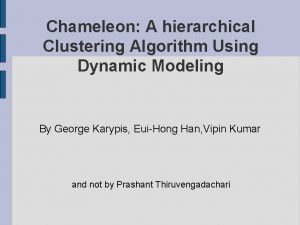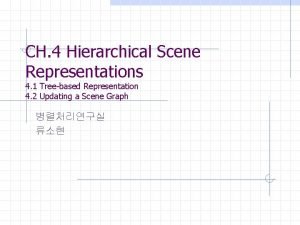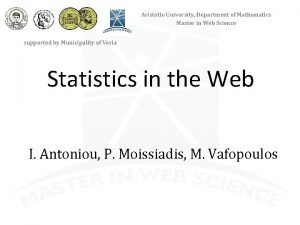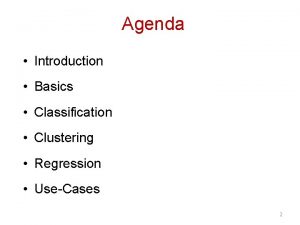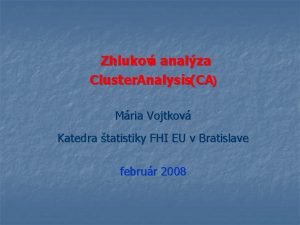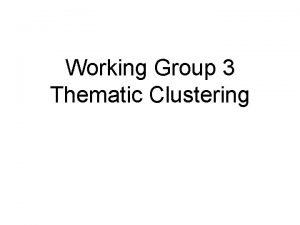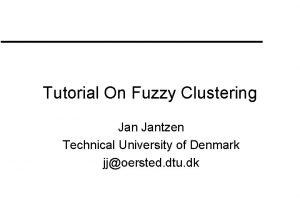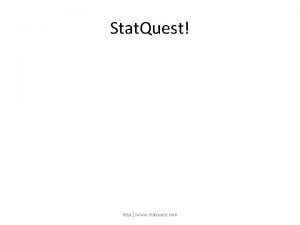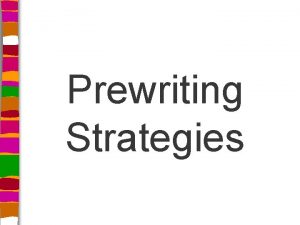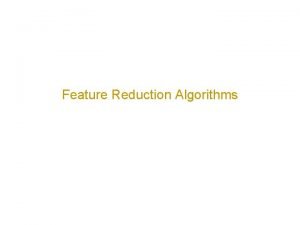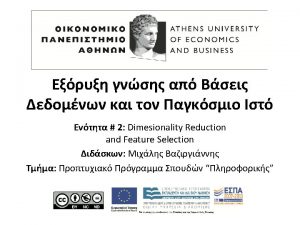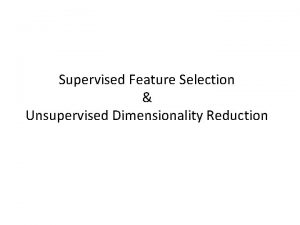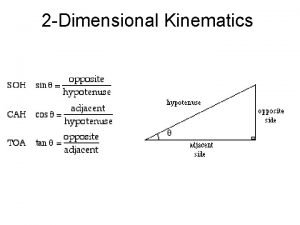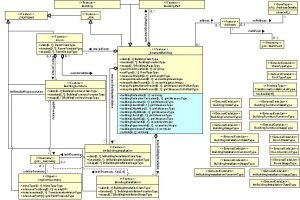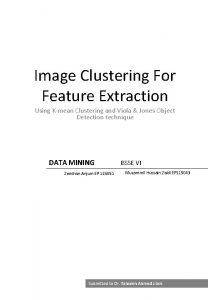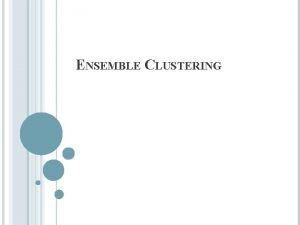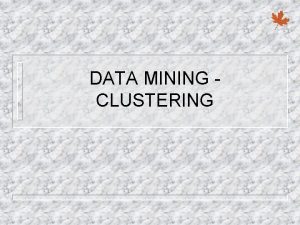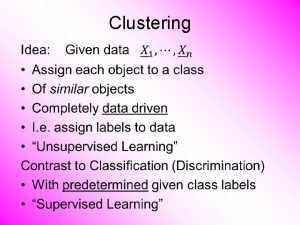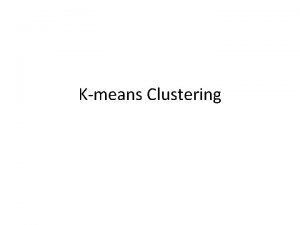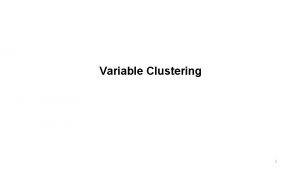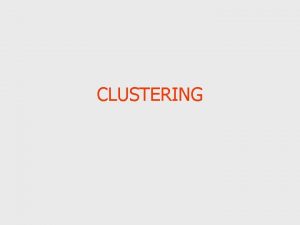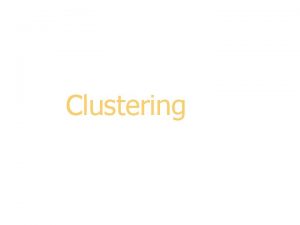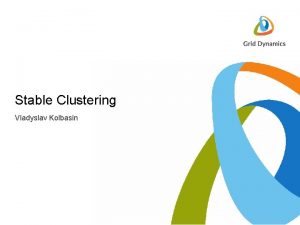Dimensional reduction feature selection and clustering techniques Alex







































































- Slides: 71

Dimensional reduction, feature selection and clustering techniques Alex Rodriguez International School for Advanced Studies (SISSA), Trieste, Italy

Outline • • • Motivation for Clustering Feature selection and Dimensional reduction Similarities and Distances Flat, fuzzy and Hierarchical clustering methods K-means clustering

Motivation for clustering Summer School on Machine Learning in the Molecular Sciences

What is a cluster? ? ? Structure underlying your data

Data mining tool that can be used for: • Decide which set of drugs from a big library we should synthetize and test. • WWW (googling…) • Image recognition • Classify plants, animals (biology), books(libraries), everything …

Why Clustering? “Understanding our world requires conceptualizing the similarities and differences between the entities that compose it” (Tyron and Bailey, 1970). • Clustering ≠ Classification – Clustering generate groups – Classification generate groups & labels – Unsupervised learning

Clustering and MD How to make sense of this amount of information? Elber, R. , & Karplus, M. (1987). Multiple conformational states of proteins: a molecular dynamics analysis of myoglobin. Science, 235(4786), 318 -321.

Clustering procedure Data Samples Feature Selection (objective related) Clustering Knowledge Interpretation (Expertise) Validation (are the groups meaningful? )

Characteristics of the data sample • Raw characteristics: – Number of features (Dimension) – Number of samples (Cardinality) – Type of features (Reals, integers, binary, qualitative) • Learned characteristics: – Statistics (Variances, covariances, averages…) – Intrinsic dimension. – Clustering…

My stone collection Categorical Integer Number Weight (g) Wavelenght (nm) Real Shape Volume Rugosity 1 20 450 spherical 0, 2 1, 04 2 33 698 cube 0, 4 1, 3 3 12 543 cube 0, 2 0, 8 4 70 691 spherical 1, 1 1, 9 5 120 465 cube 0, 3 0, 2 6 45 486 cube 0, 8 0, 3 7 136 504 cube 1, 35 0, 5 8 20 504 spherical 0, 2 0, 5 9 54 623 spherical 0, 5 1 10 93 430 spherical 0, 7 1 ….

Feature Selection Summer School on Machine Learning in the Molecular Sciences

Feature Selection & Dimensionality reduction • Highly related with the problem that we want to solve • It may need feedback from the whole process • Feature selection usually depends on labeled data (semi-supervised clustering) while dimensionality reduction does not. • Feature selection can be based on expertise…

Feature selection Features Ground Truth Try to extract which features contain relevant information for reproducing the ground truth classification

Techniques for Feature Selection (1) Variable Ranking • Which variables explain better the labels? Quantify it.

Techniques for Feature Selection (1) Variable Ranking •

Techniques for Feature Selection (1) Information Theoretic Ranking A kind of single variable classifier. In continuous variables, the sums become integrals Extensible to continuous variables by non parametric density estimation Using a Gaussian distribution for estimating the density will lead to a similar criteria to the correlation coefficient. • Is a formalization of the intuition that the higher the joint distribution, the higher the mutual information, i. e. the higher should it be in the rank. • •

Techniques for Feature Selection (1) Information Theoretic Ranking • The probabilities, in a discrete case are estimated from frequency counts. • Imagine a three class problem (red, green, blue) with a discrete variable that can take 4 values (A, B, C, D). – P(y) are 3 frequency counts. – P(x) are 4 frequency counts. – P(x, y) are 12 frequency counts.

Techniques for Feature Selection (1) Information Theoretic Ranking A B C D

Techniques for Feature Selection (1) Information Theoretic Ranking A B C D

Techniques for Feature Selection (1) Some questions about Variable Ranking • How to treat redundant variables? – Redundant variables get the same information but its combination can lead to noise reduction. – Correlation is a measure of redundancy • A variable useless by itself can be useful together with others

Features useful only in combination A B

Features useful only in combination: which combination of A and B will be useful for separate the two clusters? A B

Techniques for Feature Selection (2) Subset selection • Wrappers: Use the predicting power of a given learning machine to assess the usefulness of a given subset – How to search the space? (Brute force is NP hard. ) – How to assess the performance of the prediction? – Which learning machine shall we use?

What if we don’t have a response function? Dimensionality Reduction

Dimensionality Reduction Summer School on Machine Learning in the Molecular Sciences

Techniques for Dim. reduction Van Der Maaten, L. , Postma, E. , & Van den Herik, J. (2009). Dimensionality reduction: a comparative. J Mach Learn Res, 10, 66 -71. PCA Geodesic Distance Isomap Kernel –Based Kernel PCA Diffusion Distance Diffusion Maps Reconstruction Weights LLE Neighborhood graph Laplacian Eigenmaps Local Tangent space Hessian LLE Full Spectral Convex Sparse spectral Dimensionality Reduction Non-Convex Euclidean Distance Weighted Euclidean distances Sammon Mapping Alignment of local linear modes LLC Man. Charting Neural Network Autoencoder

2 nd Principal Component, u 2 1 st Principal Component, u 1

PCA Scores xi 2 yi, 1 yi, 2 xi 1

PCA Eigenvalues λ 1 λ 2

PCA. How to… •

Choosing the number of PC’s •

Similarities and distances Summer School on Machine Learning in the Molecular Sciences

Similarity and Distances •

Similarity and Distances almost the same but… A (metric) distance must accomplish: 1. Symmetry: d(x, y) = d(y, x) 2. Non-negativity: d(x, y) ≥ 0 3. Identity of indiscernibles: d(x, y) = 0 ⇔ x = y 4. Triangle inequality: d(x, z) + d(z, y) ≥ d(x, y) We have to take this into account for some clustering algorithms

Quantitative Features: Metric Distances •

Quantitative Features: Not metric distances •

Qualitative Features •

More complicated distances • Working in the metric can extremely simplify the clustering work. • A good metric can dramatically improve the performance of an algorithm. • However, usually they need to compute a simplest distance as starting point. • Example: Geodesic distance

Geodesic distance

Flat, hierarchical and fuzzy clustering Summer School on Machine Learning in the Molecular Sciences

Clustering procedure Cardinality, Dimension, type Feature ranking, PCA, distances Data Samples Feature Selection (objective related) Clustering Knowledge Interpretation (Expertise) Validation (are the groups meaningful? )

What is a cluster (revisited)

What is a cluster (revisited)

What is a cluster (revisited)

What is a cluster (revisited)

What is a cluster (revisited)

What is a cluster (revisited)

What is a cluster (revisited)

Some consideration about Clustering • Tautology: the result of the clustering process depends on your cluster definition • And it depends on the metric • And it also depends on the features that you have chosen

Flat, fuzzy and hierarchical clustering • Flat clustering performs a hard partition of the data • Fuzzy clustering is a flat clustering algorithm with soft element assignation • Hierarchical clustering generates a tree instead of a single partition. Can be agglomerative (joining elements) or divisive (dividing the dataset)

Flat clustering •

Flat clustering 1 2 5 3 4

Fuzzy clustering •

Fuzzy clustering

Hierarchical clustering • Produces a set of nested clusters organized as a hierarchical tree • Can be visualized as a dendrogram (A tree-like diagram that records the sequences of merges or splits) • No assumptions on the number of clusters • Hierarchical clusterings may correspond to meaningful taxonomies • It can be transformed in many hard partitions

Hierarchical clustering

Flattening the hierarchical clustering

K-means: A flat clustering algorithm Mac. Queen, J. (1967, June). Some methods for classification and analysis of multivariate observations. In Proceedings of the fifth Berkeley symposium on mathematical statistics and probability (Vol. 1, No. 14, pp. 281 -297). * *~20000 cites!!!

K-means clustering • Attempts to minimize the intracluster distance while maximizing the intercluster distance. • It is based on the concept of cluster centroid, i. e. the average position of the cluster elements. • Still widely used. • It can be easily parallelized and linearized. • User must provide k

K-means objective function •

k-means algorithm • Minimize intra distance Maximize inter distance

k-means illustration

k-means illustration Voronoi diagram

k-means illustration

k-means illustration

k-means illustration

K-means weakness • Initialization sensitive (local optimization) →kmeans++ • Which k-employing →Scree test • Sensitive to outliers →k-medoids • employs Euclidean distance →k-medoids • Only for spherical clusters →kernel k-means (advanced)

Better initialization: k-means++ • new center should be far away from existing centers

Scree test for k-means Dissimilarity The best K is 3. 1 2 3 4 Number of Clusters 5 6 7

K-medoids • It can be used with all kind of distances. • Reduces the impact of outliers. • Instead of working with centroids, it works with medoids, i. e. the most central element of the cluster. • The cluster medoid is the element with minimum sum of distances to the rest of the elements of the cluster

K=2 K=3 K=4
 Nyt top stories
Nyt top stories Partitional clustering vs hierarchical clustering
Partitional clustering vs hierarchical clustering Rumus euclidean distance
Rumus euclidean distance A circular motion is one dimensional
A circular motion is one dimensional Ml algorithm
Ml algorithm Feature dataset vs feature class
Feature dataset vs feature class Isolated feature combined feature effects
Isolated feature combined feature effects Two way selection and multiway selection in c
Two way selection and multiway selection in c Multiway selection in c
Multiway selection in c Mass selection and pure line selection
Mass selection and pure line selection Information gain feature selection
Information gain feature selection Information gain feature selection
Information gain feature selection Sequential feature selection
Sequential feature selection Data preparation and preprocessing
Data preparation and preprocessing Weka feature selection
Weka feature selection Cycle time reduction techniques
Cycle time reduction techniques Thalia mililani
Thalia mililani Balancing selection vs stabilizing selection
Balancing selection vs stabilizing selection Similarities
Similarities K selected
K selected Natural selection vs artificial selection
Natural selection vs artificial selection Artificial selection vs natural selection
Artificial selection vs natural selection Disruptivr selection
Disruptivr selection Logistic model of population growth
Logistic model of population growth Natural selection vs artificial selection
Natural selection vs artificial selection Realistic job preview advantages and disadvantages
Realistic job preview advantages and disadvantages Characteristics of effective selection techniques
Characteristics of effective selection techniques Unadjusted top down selection
Unadjusted top down selection The trajectory
The trajectory Classification and clustering in data mining
Classification and clustering in data mining Classification and clustering
Classification and clustering Fonction technique scooter
Fonction technique scooter Clustering vs classification
Clustering vs classification Sota methods
Sota methods Graph clustering by flow simulation
Graph clustering by flow simulation Hydrophobic clustering
Hydrophobic clustering Spectral clustering
Spectral clustering Brown clustering
Brown clustering What is clustering
What is clustering Tableau clustering algorithm
Tableau clustering algorithm Spectral clustering
Spectral clustering Hcs clustering algorithm
Hcs clustering algorithm Example of group technology layout
Example of group technology layout Dbscan hierarchical clustering
Dbscan hierarchical clustering Cure: an efficient clustering algorithm for large databases
Cure: an efficient clustering algorithm for large databases Bi clustering
Bi clustering Spectral clustering
Spectral clustering Clustering vs classification
Clustering vs classification Clustering ideas
Clustering ideas Bfr algorithm example
Bfr algorithm example Clustering by passing messages between data points
Clustering by passing messages between data points Clustering vs classification
Clustering vs classification Birch clustering
Birch clustering Birch in data mining
Birch in data mining Global clustering coefficient
Global clustering coefficient Global clustering coefficient
Global clustering coefficient Jarvis patrick clustering
Jarvis patrick clustering Constrained k means clustering with background knowledge
Constrained k means clustering with background knowledge Clustering slides
Clustering slides Clustering non numeric data
Clustering non numeric data Clustering in business intelligence
Clustering in business intelligence Chameleon clustering
Chameleon clustering Bayesian hierarchical clustering
Bayesian hierarchical clustering Global clustering coefficient
Global clustering coefficient Metoda k-średnich
Metoda k-średnich Ebay
Ebay A framework for clustering evolving data streams
A framework for clustering evolving data streams Clustering metoda
Clustering metoda Thematic clustering
Thematic clustering Fuzzy clustering tutorial
Fuzzy clustering tutorial Statquest
Statquest Prewriting strategies definition
Prewriting strategies definition




